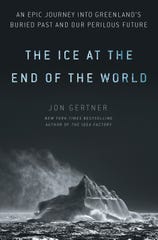Greenland is Melting

Greenland is an odd, faraway place near the top of the world. Despite being the largest island on the planet, three times the size of Texas, hardly anyone lives there: fewer than 60,000 people. And precious few visit, mostly scientists trying to fathom the secrets of its forbidding environment. Temperatures of minus 89 degrees Fahrenheit have been recorded there.
When humanity thought of Greenland at all, it was because of the explorers who challenged its vast ice sheet – roughly 80% of its land mass is covered with ice, 2 miles thick in spots. Early in the Cold War, America established an air base there and later tried to purchase Greenland from Denmark.
In his new book “The Ice at the End of the World: An Epic Journey into Greenland’s Buried Past and Our Perilous Future” (Random House, 448 pp., ★★★½ out of four), Jon Gertner makes a compelling case that it’s time to start thinking seriously about Greenland and its growing relevance to our lives, and those of our descendants.
The scientists who have braved Greenland’s environs with ever-more-sophisticated measuring tools are united in their belief that Greenland is changing faster than anyone had thought possible. As goes Greenland, so goes the planet.
Gertner, a journalist for The New York Times, does not wax polemic. That would be overkill when the facts on the ground (or on the ice) largely speak for themselves. Most of his book consists of engaging accounts of the explorers and scientists who have been drawn to Greenland’s hinterlands, among them the Norwegian Fridtjof Nansen and the American Robert Peary.
These sojourners came to conquer the elements but also to understand this strangely beautiful place. Scientists have probed and taken Greenland’s measure for more than a century, and the data they have accumulated has them concerned. The island is shedding massive amounts of ice and water each year – 300 billion tons, and the pace of loss is accelerating.
Most of Greenland lies within the Arctic Circle, and its fearsome weather has been getting less and less terrifying of late. In February 2018, scientists at the northern tip of the island, a mere 400 miles from the North Pole, recorded average daily temperatures 45 degrees above normal. To put that in perspective, if such a phenomena were recorded in February in New York City, the average temperature would hover around 80 degrees for 28 days straight.
As Earth warms, northerly places like Greenland are warming faster, as climatologists have predicted for decades now. Gertner writes that its average summer temperature is now 7 to 9 degrees warmer than normal.
Such disturbing tidbits are woven into the author’s compelling narrative about the intrepid human beings whose curiosity about the world lures them to forbidding places. Gertner makes clear that science is not augury and that there are many possible eventualities for our shared future, albeit most quite troublesome and some downright apocalyptic.
One of the most concerning findings, discovered by drilling deep into Greenland's core and unlocking the secrets of its frozen past, is that climate change has not always been gradual, as scientists had long believed. There have been points of no return in the past when a telltale threshold was crossed, when ice sheets collapsed quickly and temperatures spiked dramatically.
What if the worst happened? Gertner writes that the scientists who have taken the measure of Greenland and its melting ice calculate that if it all melted away – a distinct possibility – this island alone would account for a worldwide sea rise of nearly 25 feet.